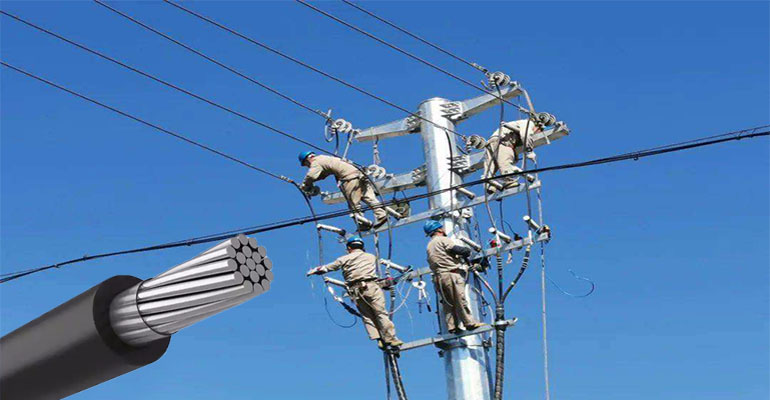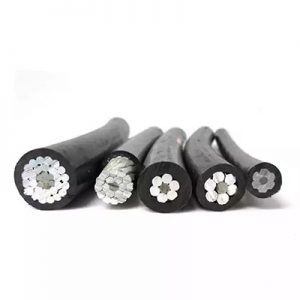- Offices Time:24 Hours Online
- Email:[email protected]
- WhatsApp:+8618339938759

Posted on December 13, 2022
The main technical performance of Aerial cable
Aerial cables have the main characteristics of high power supply reliability, good power supply security, convenient erection and maintenance, and reasonable economy. Its main technical parameters include weather resistance, insulation level, inner and outer semi-conductive shielding layers. Aerial cables are widely used in power transmission at home and abroad.
1.Weather resistance
The insulation of high-voltage overhead cables must not only meet high electrical performance requirements, but also require good weather resistance so that they can work safely under sunlight for a long time. Existing insulating materials for overhead cables are blended with polymer insulating materials and a certain amount of carbon black. Because polymer insulating materials can reject visible light and infrared light, which account for more than 94% of energy, so that they cannot penetrate into the interior of the polymer, but there is still a small amount of ultra-violet light that can penetrate into the interior of the insulation. Molecular cracking, the surface of the insulation becomes rough or even cracked, eventually destroying the insulation. If more than 2% carbon black is added to the insulation, it can completely prevent the intrusion of VA light, but this is not good for the electrical insulation performance of the cable, and the GT value will increase sharply. In order to solve this contradiction, the cable insulation is the best weather-resistant cross-linked insulation formula determined after different formulas and many tests. This formula has been successfully trial-produced by some manufacturers, and the cross-linked overhead cables produced with this material have also been officially put into use. run.

2.Insulation level
When the Aerial cable is used, since the ground voltage is not completely applied to the cable insulation, most of the ground is borne by the air medium, so the insulation performance of the Aerial cable is higher, and it is obviously better than ordinary oil paper and ordinary oil paper. Cross-linked cables. Because the lead sheath of the oil-paper cable and the shielding layer of the cross-linked cable are usually grounded, the voltage passed by the cable is completely applied to the main insulation, while the aerial cable is jointly borne by the main insulation and the air medium. Therefore, the relevant standards of various countries have stipulated that the insulation thickness of the aerial cable is thinner than that of the ordinary ground cable. In some countries, the insulation thickness of the aerial cable is 10-20% thinner than that of the ordinary cable. At the same time, under the action of long-term voltage, the insulation quality of overhead cables will not decrease significantly, unlike buried cables that will produce water trees during long-term operation. When the water trees reach saturation, the breakdown voltage of the cables will drop by 1/3-1/2 , and aerial cable generally does not produce water trees. Therefore, comprehensively, the insulation performance of the aerial cable is relatively high.

3.Inner and outer semi-conductive shielding layer
1kV Aerial Bundled Cable, because the electric field intensity on the surface of the conductor is very low, there is no need to use an inner semi-conductive shielding layer. When the aerial cable is close to the grounding body, the electric field strength on the surface of the 10kV overhead cable conductor is 2-3kV/mm, and the electric field strength on the surface of the 35kV overhead cable conductor can be as high as 5kV/mm, which requires the use of the inner semiconducting layer. Because the conductor and the insulating layer in the cable are not bonded firmly, the two layers will be separated from each other under the change of temperature. In case of cloudy and rainy weather, the separated part will be filled with water vapor, which will reduce the electric strength. When dry, the electric strength of air can reach 3kV/mm, while that of wet air is only 0.5-1KV/mm. In this way, when the cable is running under normal conditions, a layer of corona is formed between the conductor surface and the insulation gap, which not only causes corona discharge loss, but also easily destroys the insulation medium. For this reason, all countries in the world use the inner semi-conductive shielding layer of the conductor for aerial cables above 10kV.
It is not necessary to use the outer semi-conductive shielding layer for the phase-separated single-core overhead cable, but the outer semi-conductive shielding layer must be used for the three-core interwoven overhead cable above 10kV. Because the external electric field of the three-core woven overhead cable is uneven, if there is no outer semi-conductive shielding layer, a strong corona discharge will be generated when the air is humid.
Post categories
Most Popular Posts
-
The 136th Canton Fair welcomes you to participate!
October 12, 2024 -
High temperature cable introduction
July 26, 2024 -
Kenya Power and Energy Exhibition 2024
June 11, 2024 -
Introduction of rubber sheathed cable
June 5, 2024





